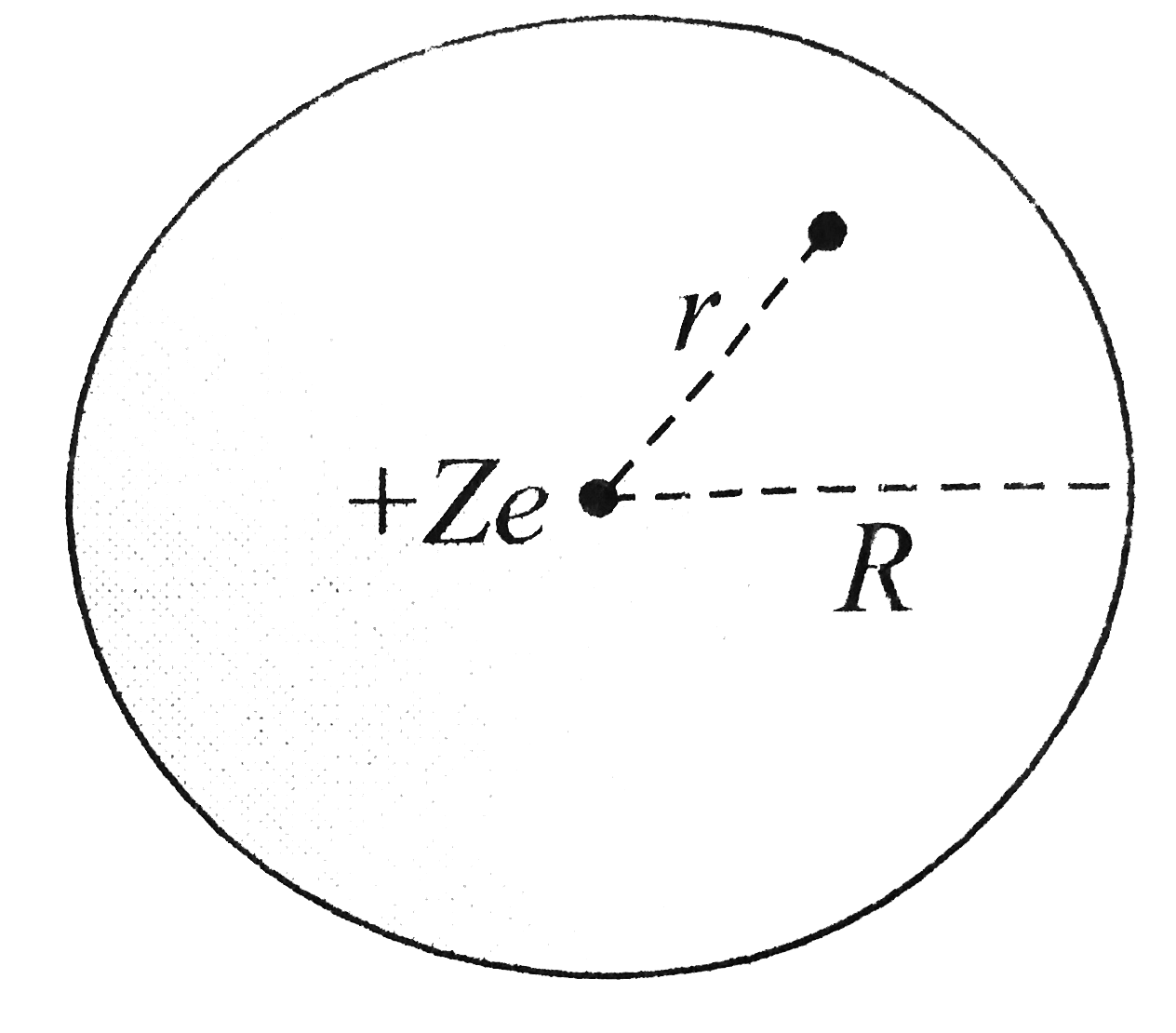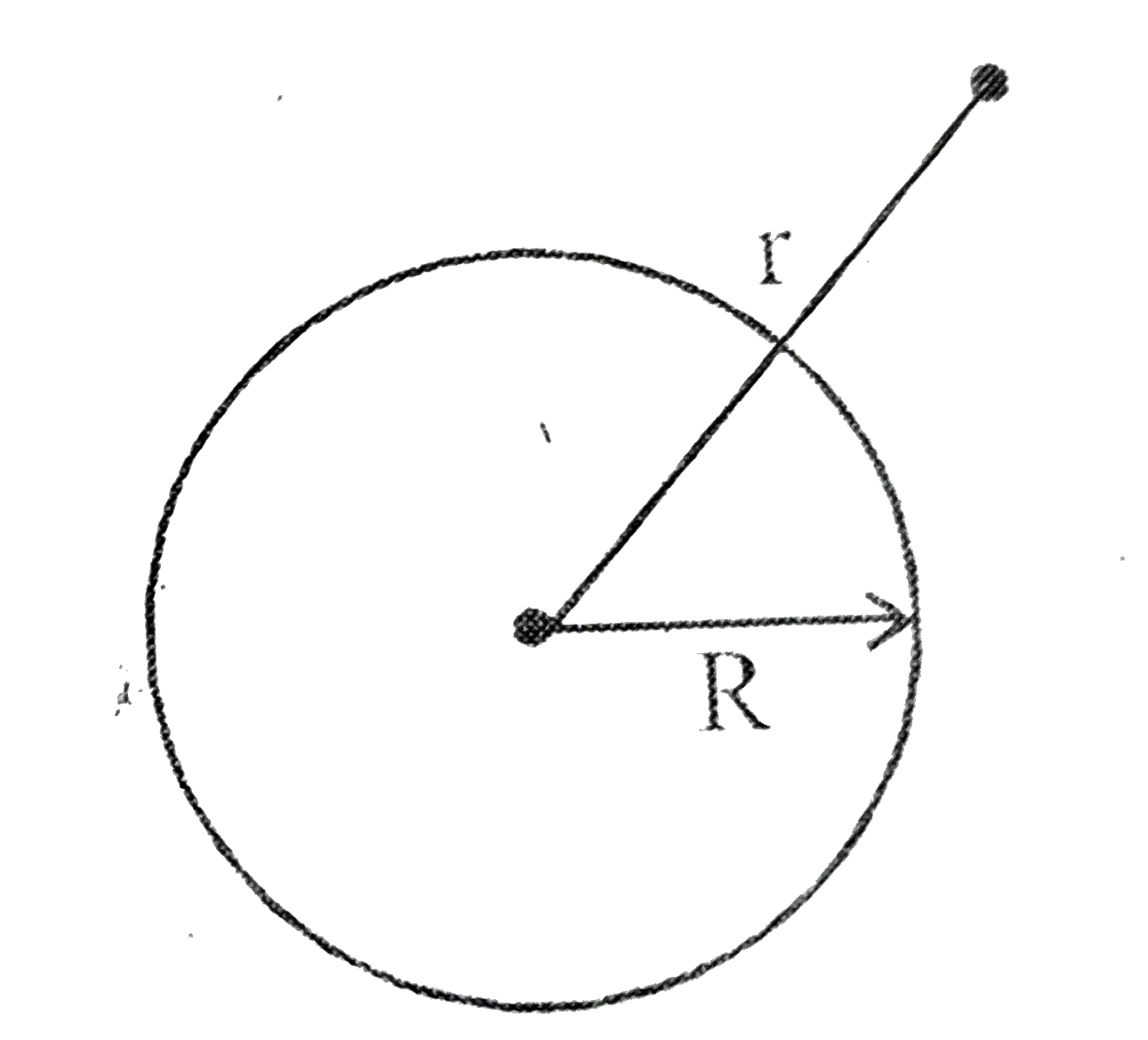According to early model of an atom,the atom is considered it to have a positively charged point nucleus of charge Ze surrounded by a uniform density of negative charge up to a radius R. The atom as a whole is neutral. The electric field at a distancer from the nucleus is (r<R)

The charge distribution for this model of the atom is as shown in Fig. 1.32. The total negative charge in the uniform spherical charge distribution of radius R must be –Z e, since the atom (nucleus) of charge Z e + negative charge) is neutral. This immediately gives us the negative charge density r, since we must have
4πR23ρ=0−Ze
4πR23ρ=0−Ze
orρ=−3Ze4πR2 To find the electric field E(r) at a point P which is a distance r away from the nucleus, we use Gauss’s law. Because of the spherical symmetry of the charge distribution, the magnitude of the electric field E(r) depends only on the radial distance, no matter what the direction of r. Its direction is along (or opposite to) the radius vector r from the origin to the point P. The obvious Gaussian surface is a spherical surface centred at the nucleus. We consider two situations, namely, r<Randr>R.
(i) r<R: The electric flux f enclosed by the spherical surface is
ϕ=E(r)×4πr2
where E(r)is the magnitude of the electric field at r. This is beacuse the field at any point on the spherical Gaussian surface has the same direction as the normal to the surface there, and has the same magnitude at all points on the surface. The charge q enclosed by the Gaussian surface is the positive nuclear charge and the negative charge within the sphere of radius r, i.e.q=ze+4πr33ρ
Substituting for the charge density ρ obtained earlier, we have
q=Ze−Zer3R3
Gauss's law then gives.
E(r)=Ze4πε01r2−rR3:r<Ra
The electric field is directed radially outward.
(ii) r>R: In this case, the total charge enclosed by the Gaussian spherical surface is zero since the atom is neutral. Thus, from Gauss’s law,
E(r)×4πr2=0orE(r)=0:r>R
At r=R, both cases give the same result E=0
Topper's Solved these Questions
- BOOK - NCERTCHAPTER - ELECTRIC CHARGES AND FIELDSEXERCISE - EXERCISE34videos
ELECTRIC CHARGES AND FIELDS
- BOOK - NCERTCHAPTER - DUAL NATURE OF RADIATION AND MATTEREXERCISE - Exercise37videos
DUAL NATURE OF RADIATION AND MATTER
- BOOK - NCERTCHAPTER - ELECTROMAGNETIC INDUCTIONEXERCISE - Exercise17videos
ELECTROMAGNETIC INDUCTION
Similar Questions
According to early model of an atom,the atom is considered it to have a positively charged point nucleus of charge Ze surrounded by a uniform density of negative charge up to a radius R. The atom as a whole is neutral. The electric field at a distancer from the nucleus is (r<R)
 View Solution
View SolutionAccording to early model of an atom,the atom is considered it to have a positively charged point nucleus of charge Ze surrounded by a uniform density of negative charge up to a radius R. The atom as a whole is neutral. The electric field at a distancer from the nucleus is (r<R)
 View Solution
View Solution
Knowledge Check
- Question 1 - Select One
An early model for an atom considered to have a positively charged point nucleus of charge Ze surrounded by a uniform density of negative charge up to a radius R. The atom as a whole is neutral. For this model, what is the electric field a distance r from the nucleus, where r>R ?
A14πε0Zer2B14πε0ZeR2C14πε0Zer2−R2D0 - Question 2 - Select One
A sphere of radius R has a charge density σ. The electric intensity at a point at a distance r from its centre is
AE=σR2∈0kr2BE=σ∈0kCE=R2DE=∈0kr2σ2 - Question 3 - Select One
The existence of a positively charged nucleus in an atom was discovered by
AThomsonBRutherfordCMaxwellDBohr
An early model for an atom considered it to have a positivelly charged point nucleus of charge +Ze surrounded by a uniform density of negative charge up to a radius R. The atom as whole is neutral. For this model , what is the electric field at a distance r from the nucleus when
r<R
r=R ?Use Gauss's theoremView SolutionWhat is the positive charge on the nucleus of an atom due to ?
View SolutionState Gauss 'law in electrostatics.
Consider an overall neutral sphere of radius R. This sphere has a point charge +Q at its centre and this positive charge is surrounded by a uniform density ρ of negative charges up to a radius R.
Use Gauss, law to obtain expression for the electric field , of this sphere , at a point distant r, from its centre ,where
r<R,
r>R
Show that these two expressions give identical results, for the electric field, at r= R.View SolutionIf the potential at the center of a uniformly charged sphere of radius R is V then electric field at a distance r from the center of sphere will be (r<R) : -
 View Solution
View SolutionAccording to Rutherford, the positively charged nucleus of the atom has a radius of about
View Solution

